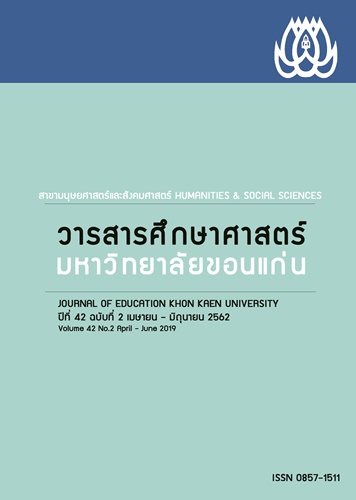องค์ประกอบและขั้นตอนการพัฒนาระบบความจริงเสมือนทางด้านการศึกษา
Main Article Content
บทคัดย่อ
เทคโนโลยีความจริงเสมือน (Virtual Reality: VR) เป็นเทคโนโลยีที่จำลองภาพเสมือน ทำให้ผู้ใช้สามารถมองเห็นได้ 360 องศา และรู้สึกเหมือนกับว่าอยู่ในเหตุการณ์หรือสถานการณ์นั้นจริง ปัจจุบันการใช้เทคโนโลยีความจริงเสมือนนอกจากความบันเทิงและเกมที่เห็นอย่างชัดเจน เทคโนโลยีนี้ยังถูกนำไปประยุกต์ใช้เป็นประโยชน์ในด้านต่างๆ เช่น ด้านการแพทย์ ด้านวิศวกรรม ด้านวิทยาศาสตร์ และด้านการศึกษา โดยเฉพาะอย่างยิ่งด้านการศึกษาได้นำไปประยุกต์ใช้ในการเรียนการสอนในเรื่องที่ซับซ้อนยากจะอธิบายให้เป็นรูปธรรม รวมถึงใช้ในการฝึกภาคปฏิบัติซ้ำๆ โดยไม่ก่อให้เกิดอันตรายต่อผู้เรียนและความเสียหายต่ออุปกรณ์เครื่องมือในห้องเรียน บทความนี้มีวัตถุประสงค์เพื่อนำเสนอองค์ประกอบที่สำคัญรวมถึงขั้นตอนการออกแบบและพัฒนาระบบความจริงเสมือนทางด้านการศึกษา และองค์ความรู้ต่างๆ ที่จำเป็นเกี่ยวกับเทคโนโลยีความจริงเสมือน ทั้งนี้เพื่อเป็นแนวทางให้ผู้ที่ต้องการจะออกแบบและพัฒนาระบบความจริงเสมือนไปใช้ในการเรียนการสอนให้เกิดประสิทธิผลมากยิ่งขึ้น
Article Details
เอกสารอ้างอิง
Borisov, N., Smolin, A., Stolyarov, D., Shcherbakov, P., & Trushin, V. (2016). The opportunities of applying the 360° video technology to the presentation of cultural events. In Brooks, A. & Brooks, E. (Eds.), DLI-2016 Proceedings of the International Conference on Design, Learning, and Innovation 2016. (pp. 256–263). Esbjerg, Denmark: Springer International Publishing.
Fan, S., Zhang, Y., Fan, J., He, Z., & Chen, Y. (2010). The application of virtual reality in environmental education: Model design and course construction. In V. E. Muchin & Z. Hu (Eds.), Proceedings of the International Conference on Biomedical Engineering and Computer Science 2010. (pp. 1–4). Ningbo, Zhejiang.
Hilfert, T., & König, M. (2016). Low-cost virtual reality environment for engineering and construction. Visualization in Engineering, 4(1), 2-18.
Hsu, C. C., Chen, Y. L., Chou, W. C., Huang, S. H., & Chang, K. K. (2018). Motorcycle Riding Safety Education with Virtual Reality. In Bilof, R. (Ed.), AIVR-2018 Proceedings of the International Conference on Artificial Intelligence and Virtual Reality. (pp. 216-218). Taichung, Taiwan.
Kabassi, K. (2017). Evaluating websites of museums: State of the art. Journal of Cultural Heritage, 24(2017), 184–196.
Kapp, K. (2017, January 3). 3 Instructional Design Strategies for Virtual Reality Learning. Retrieved December 7, 2018, from https://elearningindustry.com/instructional-design-strategies-virtual-reality-learning
Likitweerawong, K., & Palee, P. (2018). The virtual reality serious game for learning driving skills before taking practical test. In Pravesjit, S. & Sugunnasi, P. (Eds.), ICDAMT-2018 Proceedings of the International Conference on Digital Arts, Media and Technology 2018. (pp. 158–161). Phayao, Thailand.
Liou, W., & Chang, C. (2018). Virtual reality classroom applied to science education. Proceedings of the 23rd International Scientific-Professional Conference on Information Technology 2018. (pp. 1–4). Zabljak, Montenegro.
Nateeraitaiwa, S., & Hnoohom, N. (2016). Virtual reality system with smartphone application for height exposure. In Numao, M., Theeramunkong, T., Supnithi, T., Ketcham, M., Hnoohom, N. & Pramkeaw, P. (Eds.), PRICAI-2016 Proceedings of Pacific Rim International Conference on Artificial Intelligence 2016. (pp. 38–50). Phuket, Thailand: Springer International Publishing.
Pantelidis, V. S. (2009). Reasons to use virtual reality in education and training courses and a model to determine when to use virtual reality. Themes in Science and Technology Education, 2(1-2), 59–70.
Rozinaj, G., Vančo, M., Vargic, R., Minárik, I., & Polakovič, A. (2018). Augmented/Virtual reality as a tool of self-directed learning. In Planinšič, P. & Zamuda, A. (Eds.), IWSSIP-2018 Proceedings of 25th International Conference on Systems, Signals and Image Processing 2018. (pp. 1-5). Maribor, Slovenia.
Sánchez, Á., Barreiro, J. M., & Maojo, V. (2000). Design of virtual reality systems for education: A cognitive approach. Education and Information Technologies, 5(4), 345–362.
Sutherland, I.E. (1965) The ultimate display. In Kalenich, W. A. (Ed.), Proceedings of the
IFIP Congress 1965. (pp. 506–508). London, UK.
Vergara, D., Rubio, M. P., & Lorenzo, M. (2017). On the design of virtual reality learning environments in engineering. Multimodal Technologies and Interaction, 1(2), 1-12.
Vergara, D., Rubio, M. P., Prieto, F., & Lorenzo, M. (2016). Enhancing the teaching/learning of materials mechanical characterization by using virtual reality, Journal of Materials Education, 38(3–4), 63–74.
Wang, R., Yao, J., Wang, L., Liu, X., Wang, H., & Zheng, L. (2017). A surgical training system for four medical punctures based on virtual reality and haptic feedback. 3DUI-2017 Proceedings of the Symposium on 3D User Interfaces 2017. (pp. 215–216). Los Angeles, CA, USA.
Zikky, M., Fathoni, K., & Firdaus, M. (2018). Interactive distance media learning collaborative based on virtual reality with solar system subject. In Lee, R. (Ed.), SNPD-2018 Proceedings of 19th IEEE/ACIS International Conference on Software Engineering, Artificial Intelligence, Networking and Parallel/Distributed Computing 2018. (pp. 4–9). Busan, South Korea.


